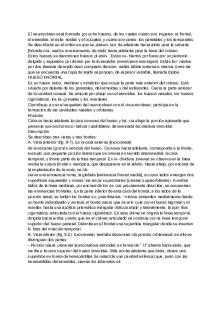Functional areas of Cerebral Cortex frontal lobe PDF

| Title | Functional areas of Cerebral Cortex frontal lobe |
|---|---|
| Author | Tory Juich |
| Course | Foundations of Anatomy |
| Institution | Southern Alberta Institute of Technology |
| Pages | 2 |
| File Size | 217.4 KB |
| File Type | |
| Total Downloads | 13 |
| Total Views | 152 |
Summary
Anatomy Notes...
Description
Functional areas of Cerebral Cortex frontal lobe Primary motor area- Brodmann’s area 4, responsible for voluntary skilled movements within precentral gyrus, supplementary motor area & premotor area- Brodmann’s area 6, responsible for planning movements less focused & related to postural movements
Neurons within precentral gyrus somatopically organised- diff parts of gyrus associated w distinct part of body both functionally & anatomically. Primary motor area & motor homunculus: Motor homunculus indicates location of areas of the primary motor cortex that control movements of body part depicted When the parts of the body are drawn in terms of the degree of their cortical representation (i.e., in the form of a somatotopic arrangement), the resulting homunculus demonstrates the disproportionate body representation i.e. note the large area (and large number of neurons) that correspond to movements of the hand compared to the smaller area corresponding to movements of the lower limb…. An injury to the primary motor cortex, for example as a result of a stroke, will result in an upper motor nerve lesion syndrome– the patient will exhibit spastic paralysis, clonus and hyperreflexia
Brocca’s motor speech area (44 & 45) (left side) – located dominant cerebral hemisphere, responsible for formulating motor components of speech If damaged ? Brocca’s aphasia- language impairments: difficulty in naming objects and repeating words but comprehension of language remains intact.
Prefrontal (in pink)- processes intellectual & emotional events If damaged? Frontal lobe dysfunction- personality change e.g. ‘Phineas Gage history’
Parietal contains postcentral gyrus- receiving area for somatosensory (e.g. pressure, pain, temperature & touch) info from periphery (Brodmanns 1,2,3). - Strip of cortex in parietal – receives info from the opposite side of the body. - Like the motor cortex the postcentral gyrus is somatopically organised & can be depicted as having sensory homunculus which parallels that of the motor cortex. Sensory homunculus indicates location of the areas of the primary somatosensory cortex – receive sensory info from body. Disproportionate body representation – LARGE AREA- large no. of neurons corresponding to the sensations. e.g. hand vs foot, the foot has smaller area...
Similar Free PDFs

Motorische cortex
- 3 Pages

Hueso frontal
- 1 Pages

Hueso Frontal
- 6 Pages

Cortex Quercus
- 2 Pages

Functional Properties of protein
- 21 Pages

Cortex Frangulae
- 2 Pages
Popular Institutions
- Tinajero National High School - Annex
- Politeknik Caltex Riau
- Yokohama City University
- SGT University
- University of Al-Qadisiyah
- Divine Word College of Vigan
- Techniek College Rotterdam
- Universidade de Santiago
- Universiti Teknologi MARA Cawangan Johor Kampus Pasir Gudang
- Poltekkes Kemenkes Yogyakarta
- Baguio City National High School
- Colegio san marcos
- preparatoria uno
- Centro de Bachillerato Tecnológico Industrial y de Servicios No. 107
- Dalian Maritime University
- Quang Trung Secondary School
- Colegio Tecnológico en Informática
- Corporación Regional de Educación Superior
- Grupo CEDVA
- Dar Al Uloom University
- Centro de Estudios Preuniversitarios de la Universidad Nacional de Ingeniería
- 上智大学
- Aakash International School, Nuna Majara
- San Felipe Neri Catholic School
- Kang Chiao International School - New Taipei City
- Misamis Occidental National High School
- Institución Educativa Escuela Normal Juan Ladrilleros
- Kolehiyo ng Pantukan
- Batanes State College
- Instituto Continental
- Sekolah Menengah Kejuruan Kesehatan Kaltara (Tarakan)
- Colegio de La Inmaculada Concepcion - Cebu









